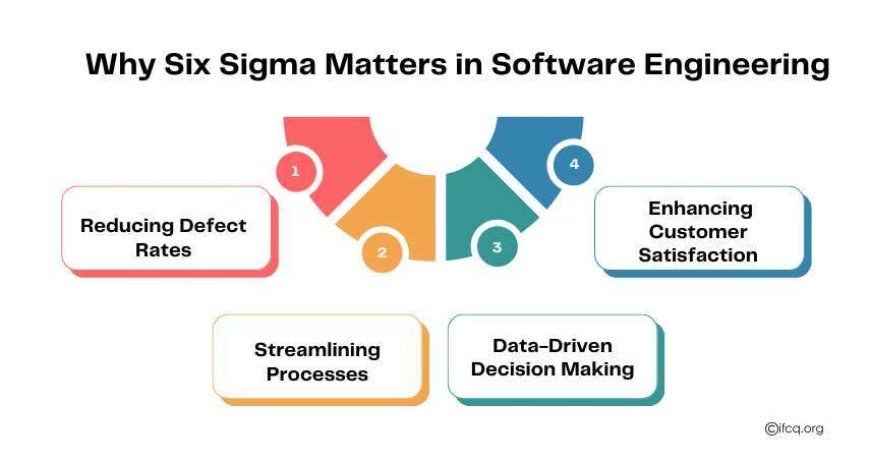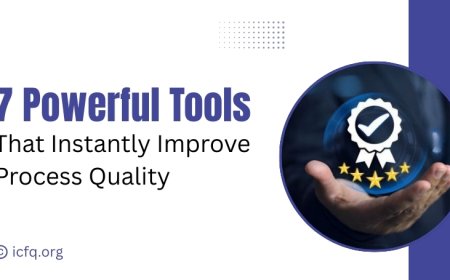How Six Sigma Improves Software Engineering Quality?
Discover how Six Sigma improves software engineering quality with easy methods that cut errors and boost efficiency fast.

In my Journey with Six Sigma, I’ve seen that true quality improvement isn’t about adding more processes; it’s about creating alignment, removing guesswork, and fostering accountability.
During one early project in the software domain, our goal was to reduce recurring bugs in a major application release. By breaking down the root causes, streamlining workflows, and keeping every stakeholder in the loop, we not only cut defect rates but also boosted deployment confidence across the team. Six Sigma taught me that lasting success comes from discipline, precision, and a commitment to measurable progress, not quick fixes.
How can the same principles that transform manufacturing also elevate software engineering quality?
And why are more tech companies investing in Six Sigma in Software Engineering than ever before?
-
According to iSixSigma, businesses implementing Six Sigma report defect reductions of up to 50% in software projects.
-
A study by Forrester found that quality-focused process improvements can cut software delivery time by 25%.
-
IBM’s internal adoption of Six Sigma led to a 12% improvement in client satisfaction scores.
Understanding Six Sigma in Software Engineering
Six Sigma is a disciplined, data-driven methodology aimed at improving processes by identifying and eliminating defects. In the context of software engineering, Six Sigma in Software Engineering involves applying these principles to software development life cycles (SDLC) to enhance quality, reduce errors, and ensure predictable delivery timelines.
The methodology is built on two main approaches:
-
DMAIC (Define, Measure, Analyze, Improve, Control) – for improving existing processes.
-
DMADV (Define, Measure, Analyze, Design, Verify) – for creating new processes or products.
Unlike traditional quality assurance, Six Sigma focuses on root cause analysis rather than surface-level fixes. This makes it ideal for large-scale software projects where precision and consistency are critical.
Why Six Sigma Matters in Software Engineering

1. Reducing Defect Rates
Every software defect not only adds cost but also delays delivery and impacts customer trust. Six Sigma techniques like Cause-and-Effect Analysis and Statistical Process Control help development teams detect and address issues before they reach production.
2. Streamlining Processes
By mapping the entire SDLC, Six Sigma identifies bottlenecks, whether in coding, testing, or deployment, and provides actionable improvements.
3. Data-Driven Decision Making
Instead of relying on guesswork, Six Sigma in Software Engineering relies on metrics such as Defects per Million Opportunities (DPMO) and First Pass Yield (FPY) to assess performance.
4. Enhancing Customer Satisfaction
Fewer bugs, timely delivery, and a better user experience lead to higher client satisfaction and long-term business growth.
Key Benefits of Six Sigma in Software Engineering
|
Benefit |
How It Helps in Software Engineering |
|
Reduced Defects |
Fewer bugs and errors in production code. |
|
Faster Delivery |
Streamlined workflows accelerate releases. |
|
Lower Costs |
Less rework and shorter development cycles. |
|
Predictable Quality |
Consistent performance across projects. |
|
Higher ROI |
Increased customer retention and sales. |
Implementing Six Sigma in Software Projects
Step 1: Define
Identify project goals, customer requirements, and problem areas. For instance, if a project has a high number of post-release defects, this becomes the focus area.
Step 2: Measure
Collect relevant data, such as defect rates, test coverage, and delivery times, to establish a baseline.
Step 3: Analyze
Use statistical tools to determine root causes of inefficiencies and defects.
Step 4: Improve
Implement targeted solutions, such as automated testing or code review processes, to address identified issues.
Step 5: Control
Maintain improvements through continuous monitoring, process audits, and team training.
Six Sigma Tools Used in Software Engineering
-
Process Mapping – Visualizing the workflow to find bottlenecks.
-
Control Charts – Tracking process performance over time.
-
Pareto Analysis – Identifying the most common defect sources.
-
Fishbone Diagrams – Pinpointing causes of recurring issues.
These tools ensure that improvements are not just one-time fixes but are sustained for the long term.
Common Misconceptions About Six Sigma in Software
-
"It’s only for manufacturing" – Six Sigma is highly adaptable to service and IT industries, including software engineering.
-
"It slows down development." – When implemented correctly, it speeds up delivery by eliminating rework.
-
"It’s too complex for small teams" – Even startups benefit from simplified Six Sigma approaches.
Challenges and How to Overcome Them
1. Resistance to Change
Many teams hesitate to adopt Six Sigma because they fear it will slow down development. The solution is proper training and leadership buy-in.
2. Data Collection Issues
Accurate data is crucial for Six Sigma. Automating data collection through tools like Jira or Azure DevOps can solve this problem.
3. Skill Gaps
Not all team members are familiar with Six Sigma. Investing in Green Belt or Black Belt training can bridge this gap.
Six Sigma in Software Engineering is not just about reducing defects; it’s about creating a culture of excellence. Businesses that integrate Six Sigma into their development process see long-term benefits in quality, cost savings, and customer satisfaction.
If your software projects often face delays, budget overruns, or quality issues, start with a small Six Sigma pilot project. Measure the results, and scale the approach across your organization for maximum impact.





























